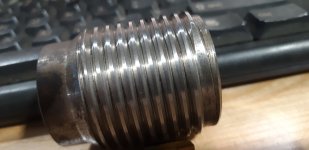maguilera
Aluminum
- Joined
- Jan 4, 2022
First and foremost, before posting here I did some research on this topic and read through a few threads on PM and they were really helpful, but still, some questions arose.
Is it an issue to use a LH tool to cut the higbee on a right hand thread?
The Z start position of the higbee should be kept the same as the threading? Or should it be displaced by the pitch or half the pitch?
Is it possible to cut a higbee using a WNMG or TNMG insert?
I believe I could get an answer for these questions by loading the program and running some test pieces, but I don't have a machine available for doing that at the present moment.
This is the program I came up using G76 for an M30x2 thread, assuming the preset is at the center tip for the threading tool and at the leading edge for the grooving tool.
(M30x2 THREAD – REAR TURRET LATHE)
T0505 (RH OD THREADING TOOL MOUNTED UPSIDE DOWN)
G97 S800 M3
G0 G54 X38 Z6
G76 P010060 Q100 R0.1
G76 X27.546 Z-22 P1340 Q420 F2
G53 G0 X350 Z440
(HIGBEE)
T0303 (3mm LH OD GROOVING TOOL)
G97 S800 M4
G0 G54 X38 Z6
G76 P010060 Q100 R0.1
G76 X27.546 Z-2 P1340 Q800 F2
G53 G0 X350 Z440
Your input is greatly appreciated.
Cheers.
Is it an issue to use a LH tool to cut the higbee on a right hand thread?
The Z start position of the higbee should be kept the same as the threading? Or should it be displaced by the pitch or half the pitch?
Is it possible to cut a higbee using a WNMG or TNMG insert?
I believe I could get an answer for these questions by loading the program and running some test pieces, but I don't have a machine available for doing that at the present moment.
This is the program I came up using G76 for an M30x2 thread, assuming the preset is at the center tip for the threading tool and at the leading edge for the grooving tool.
(M30x2 THREAD – REAR TURRET LATHE)
T0505 (RH OD THREADING TOOL MOUNTED UPSIDE DOWN)
G97 S800 M3
G0 G54 X38 Z6
G76 P010060 Q100 R0.1
G76 X27.546 Z-22 P1340 Q420 F2
G53 G0 X350 Z440
(HIGBEE)
T0303 (3mm LH OD GROOVING TOOL)
G97 S800 M4
G0 G54 X38 Z6
G76 P010060 Q100 R0.1
G76 X27.546 Z-2 P1340 Q800 F2
G53 G0 X350 Z440
Your input is greatly appreciated.
Cheers.




